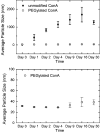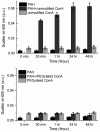PEGylation of concanavalin A to improve its stability for an in vivo glucose sensing assay
- PMID: 25133655
- PMCID: PMC4165460
- DOI: 10.1021/ac501791u
PEGylation of concanavalin A to improve its stability for an in vivo glucose sensing assay
Abstract
Competitive binding assays utilizing concanavalin A (ConA) have the potential to be the basis of improved continuous glucose monitoring devices. However, the efficacy and lifetime of these assays have been limited, in part, by ConA's instability due to its thermal denaturation in the physiological environment (37 °C, pH 7.4, 0.15 M NaCl) and its electrostatic interaction with charged molecules or surfaces. These undesirable interactions change the constitution of the assay and the kinetics of its behavior over time, resulting in an unstable glucose response. In this work, poly(ethylene glycol) (PEG) chains are covalently attached to lysine groups on the surface of ConA (i.e., PEGylation) in an attempt to improve its stability in these environments. Dynamic light scattering measurements indicate that PEGylation significantly improved ConA's thermal stability at 37 °C, remaining stable for at least 30 days. Furthermore, after PEGylation, ConA's binding affinity to the fluorescent competing ligand previously designed for the assay was not significantly affected and remained at ~5.4 × 10(6) M(-1) even after incubation at 37 °C for 30 days. Moreover, PEGylated ConA maintained the ability to track glucose concentrations when implemented within a competitive binding assay system. Finally, PEGylation showed a reduction in electrostatic-induced aggregation of ConA with poly(allylamine), a positively charged polymer, by shielding ConA's charges. These results indicate that PEGylated ConA can overcome the instability issues from thermal denaturation and nonspecific electrostatic binding while maintaining the required sugar-binding characteristics. Therefore, the PEGylation of ConA can overcome major hurdles for ConA-based glucose sensing assays to be used for long-term continuous monitoring applications in vivo.
Figures







Similar articles
-
Overcoming the aggregation problem: a new type of fluorescent ligand for ConA-based glucose sensing.Biosens Bioelectron. 2015 Jan 15;63:53-60. doi: 10.1016/j.bios.2014.07.015. Epub 2014 Jul 11. Biosens Bioelectron. 2015. PMID: 25058939 Free PMC article.
-
Glucose-binding property of pegylated concanavalin A.Pharm Res. 2001 Jun;18(6):794-9. doi: 10.1023/a:1011084312134. Pharm Res. 2001. PMID: 11474783
-
Preparation and characterization of PEGyated Concanavalin A for affinity chromatography with improved stability.J Chromatogr B Analyt Technol Biomed Life Sci. 2011 Jun 15;879(20):1732-40. doi: 10.1016/j.jchromb.2011.04.018. Epub 2011 Apr 22. J Chromatogr B Analyt Technol Biomed Life Sci. 2011. PMID: 21571597
-
Concanavalin A for in vivo glucose sensing: a biotoxicity review.Biosens Bioelectron. 2006 Aug 15;22(2):275-84. doi: 10.1016/j.bios.2006.01.008. Epub 2006 Feb 20. Biosens Bioelectron. 2006. PMID: 16488598 Review.
-
The impact of PEGylation on biological therapies.BioDrugs. 2008;22(5):315-29. doi: 10.2165/00063030-200822050-00004. BioDrugs. 2008. PMID: 18778113 Review.
Cited by
-
Targeted delivery of a short antimicrobial peptide (CM11) against Helicobacter pylori gastric infection using concanavalin A-coated chitosan nanoparticles.J Mater Sci Mater Med. 2023 Aug 31;34(9):44. doi: 10.1007/s10856-023-06748-w. J Mater Sci Mater Med. 2023. PMID: 37650975 Free PMC article.
-
A Layer-by-Layer Approach To Retain a Fluorescent Glucose Sensing Assay within the Cavity of a Hydrogel Membrane.ACS Appl Bio Mater. 2018 Nov 19;1(5):1319-1327. doi: 10.1021/acsabm.8b00267. Epub 2018 Oct 10. ACS Appl Bio Mater. 2018. PMID: 30474080 Free PMC article.
-
Computational Model-Assisted Development of a Nonenzymatic Fluorescent Glucose-Sensing Assay.ACS Sens. 2024 Nov 22;9(11):6218-6227. doi: 10.1021/acssensors.4c02117. Epub 2024 Nov 13. ACS Sens. 2024. PMID: 39536779 Free PMC article.
-
Recent Insights into Glucose-Responsive Concanavalin A-Based Smart Hydrogels for Controlled Insulin Delivery.Gels. 2024 Apr 11;10(4):260. doi: 10.3390/gels10040260. Gels. 2024. PMID: 38667679 Free PMC article. Review.
-
Plant asparaginyl endopeptidases and their structural determinants of function.Biochem Soc Trans. 2021 Apr 30;49(2):965-976. doi: 10.1042/BST20200908. Biochem Soc Trans. 2021. PMID: 33666219 Free PMC article. Review.
References
-
- Centers for Disease Control and Prevention. http://www.cdc.gov/diabetes/pubs/statsreport14.htm (accessed August 4, 2014).
-
- World Health Organization. http://www.who.int/mediacentre/factsheets/fs312/en/ (accessed August 4, 2014).
-
- Diabetes Care 2011, 34, S62. - PubMed
-
- Ballerstadt R.; Schultz J. S. Anal. Chem. 2000, 72, 4185. - PubMed
Publication types
MeSH terms
Substances
Grants and funding
LinkOut - more resources
Full Text Sources
Other Literature Sources
Medical

